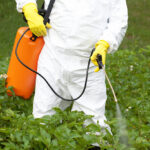Glyphosate likely responsible for alarming surge in childhood leukemia cases
 (NaturalHealth365) Childhood cancer is a terrifying prospect. It’s not a diagnosis that any parent wants to hear. While survivability is possible, the risk of this form of cancer is greater with the presence of so many toxins in our environment.
(NaturalHealth365) Childhood cancer is a terrifying prospect. It’s not a diagnosis that any parent wants to hear. While survivability is possible, the risk of this form of cancer is greater with the presence of so many toxins in our environment.
In fact, childhood leukemia and central nervous system cancers have been increasing since 2003, roughly a 1% increase per year, and some scientists have identified glyphosate as a main driver of this increase. For example, studies indicate that children and pregnant women who are exposed to glyphosate have a substantially increased risk of leukemia, lymphoma, and central nervous system cancers.
In a world where it has become increasingly commonplace to use herbicides in both landscaping and agriculture, this is troubling news. Let’s take a look at what the study found.
Cultivating danger: The hidden threat of glyphosate in our daily lives
Pesticides have often received undue praise for their contributions to humanity. Modern herbicides, fungicides, and insecticides have undeniably bolstered our food production systems. However, this benefit comes at an enormous cost, as these chemicals, now prevalent in our food supply, undeniably contribute to various diseases, with cancer being one of them.
Among these substances, glyphosate stands out as one of the culprits, ensuring bountiful crop yields while also causing unimaginable harm. Extensive evidence strongly links glyphosate to lymphoma and leukemia, making it a potent health risk.
Even more concerning is that herbicides like glyphosate aren’t limited to agricultural use; they also find their way into commercial landscaping, including areas like schools and rental properties. Even your home’s landscaping service may inadvertently use residential-grade glyphosate to maintain a weed-free lawn.
You might assume that avoiding these hazardous herbicides would be simple, but regrettably, the reality is quite the opposite.
Alarming trends: Childhood leukemia, and lymphoma rates on the rise globally
Today, we delve into a study that unveils a concerning rise in specific childhood cancer rates on a global scale. A comprehensive data collection effort spanned every corner of the world, encompassing a staggering 240,000 human participants.
Between 2003 and 2019, an alarming trend emerged when analyzing the data: an annual 1% increase in childhood leukemia, lymphoma, central nervous system tumors, and certain liver cancers. Conversely, the incidence of melanoma, while decreasing, is not typically influenced by glyphosate exposure.
While the primary study doesn’t establish causal links for this surge in cancer rates, it speculates that external factors like polluted air and water may play a significant role. Intriguingly, the types of cancer on the rise align with glyphosate exposure trends, prompting further investigation.
Mitigating risk for pediatric cancer: Protecting our children beyond glyphosate
While glyphosate is undeniably a major concern for pediatric cancer, it’s vital to recognize that it’s not the sole contributing factor. A complex interplay of various environmental and lifestyle factors influences pediatric cancer risk. Here are additional steps to protect your children from the threat of cancer.
Detoxify your home
Create a clean and toxin-free home environment. Transition to natural cleaning products, non-toxic cookware, and chemical-free personal care items. Reducing exposure to environmental toxins can significantly contribute to your children’s well-being.
Sunlight and fresh air
Ensure your children spend time outdoors in natural sunlight and fresh air. Vitamin D from sunlight is essential for a robust immune system and overall health. Encourage outdoor activities and nature exploration.
Promote a healthy, organic diet
Childhood obesity and highly processed foods are increasingly linked to cancer development. Excess weight and a diet rich in processed, sugary foods can contribute to systemic inflammation, which fosters cancer growth.
Prioritize a diet centered on organic, whole foods, and limit sugar consumption. Encourage your children to consume organic fruits, vegetables, lean proteins, and healthy fats like, avocados, nuts and seeds. Teach them about the benefits of a balanced diet for their overall health and well-being.
Holistic healthcare
Consider seeking holistic healthcare professionals, such as naturopathic doctors or holistic pediatricians, to provide comprehensive care for your children. These practitioners focus on treating the whole person and often incorporate natural therapies and lifestyle adjustments.
Natural immune boosters
Explore natural immune-boosting remedies to support your children’s defenses. Incorporate foods rich in immune-enhancing nutrients like vitamin C, zinc, and probiotics.
Additionally, consider herbal supplements like echinacea and elderberry, known for their immune-boosting properties.
Encourage an active lifestyle
Regular physical activity can play a pivotal role in reducing cancer risk. Encourage your children to engage in outdoor activities, sports, and exercise. Not only does this promote physical health, but it also limits sedentary behaviors associated with obesity.
Protecting your children from pediatric cancer is like piecing together a puzzle with many parts. Your actions not only help shield them from glyphosate’s potential harm but also enable them to live healthy and happy lives.
Sources for this article include:



